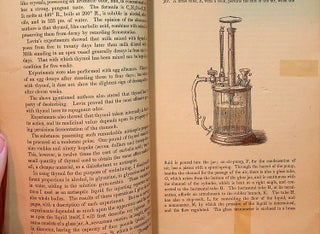On a Method of Embalming the Dead by the use of Thymol
Philadelphia: Printed for the Russian Commission 1876. First Edition. 10 pages plus tan printed wrappers. 8vo (5 3/4 x 8 7/8 inches). Condition leaves much to be desired - the pamphlet has singificant cellotape "repairs" including to the spine and many internal tears. While this does not impair it's readability, conserving it would take some work. Among other condition defects, there appears to be a tape removal front lower left (library?), several stains, several puncture marks extending through the pamphlet, and needless cellotape repairs to most pages. This is a case where the bookseller has to weigh condition, rarity, and desirability of the topic while pricing. Fair. Pamphlet. [27475]
Printed at the Centennial Exposition of 1876 by Campbell Press Print, Centennial Grounds. The Campbell Press had a building on the grounds of the 1876 exposition and (we assume given the printer's slug on this pamphlet) conducted printing on site. This pamphlet was printed for the Russian Commission.
Dr. Wywodzoff, of St. Petersburg Russsia, authored a book on history of and practical embalming, and here discusses a method using Thymol and his Wywodzoff's mechanical "injector" (illustrated). He describes experiments using this method and their results, and includes a description and definition of items that have been successfully embalmed! While many things displayed at exhibitions are for general delight of the viewer, this one has some practical applications. The American Journal of the Medical Sciences, Volume 72, pp 556-557 heaped high praise on this new device. After a fairly thorough discussion of what they saw, the authors note: "The results obtained by this process are certainly the best we have ever seen. In specimens exhibited by Dr Wywodzoff several months after injection the skin retained its original colour and the muscles and joints were in their natural soft and flexible condition. The method is extremely well adapted for the preservation of subjects for dissection and we would strongly recommend its trial to all who are engaged in teaching practical anatomy."
Scarce, with only 6 reported copies in OCLC (Acc# 19790901).
ITEM SOLD



